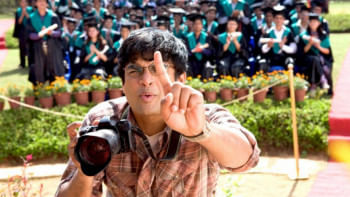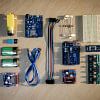Career prospects to explore as an EEE graduate

When I chose Electrical and Electronic Engineering (EEE) after getting admitted to university, it wasn't out of a grand passion for circuits or machines. I was told that EEE graduates had better chances at landing government jobs. To me, it was always easier to picture what a Computer Science and Engineering (CSE) or Civil Engineering graduate actually did. But as I sat through my first few classes as an EEE undergraduate student, one question kept circling in my mind — what does an electrical engineer actually do?
Breaking down the EEE field
EEE, in general, can broadly be divided into 3 majors: Electronics and Photonics, Communication and Signal Processing (CSP), and Electrical Energy and Power Systems (EEPS).
The field of Electronics and Photonics explores materials at the nanoscale level that are used to develop faster, smaller, and more efficient devices. By studying how materials behave at this level, it is possible to design advanced electronic and photonic components.
CSP dives into advanced communication systems that power today's interconnected world. The field also integrates artificial intelligence (AI), machine learning (ML), and the IoT (Internet of Things) to create smarter, more efficient networks — spanning wireless, optical, and satellite systems. Signal processing forms the core of this innovation, enabling AI to interpret complex data through techniques like noise reduction and pattern recognition.
Lastly, EEPS deals with modelling and controlling complex power networks to ensure stable and efficient electricity flow. It focuses on integrating renewable sources, managing inverter-based systems, and preventing large-scale outages.
Pursuing research in EEE
Among EEE graduates, pursuing a career in research, especially abroad, is a widely popular choice, now more than ever. For those looking to pursue research in EEE, Chinmoy Biswas, a graduate research assistant at Canada's National Institute of Scientific Research, suggests doing so as an undergraduate student.
"Most universities now offer the option to pursue an undergraduate thesis in the final year, so that's a good point to start," says Biswas. "If you have a decent CGPA, I don't recommend getting into research earlier than the final year. But you can always reach out to a professor of your choice and start working independently with them alongside your thesis. Of course, one needs to be aware of the maximum workload they can handle, as working on multiple projects with different professors or supervisors without results doesn't amount to much. It might end up hampering your CGPA without amounting to any significant advantage."
As a graduate research assistant, Biswas's key responsibilities include performing research, reading papers, writing conference and journal manuscripts, and presenting research work at conferences.
For pursuing a master's or a PhD abroad, Biswas suggests ensuring that one actually enjoys conducting research before just jumping on board. He says, "Research abroad includes some downsides and upsides. The upsides include the promise of a better life, a job with a better salary, and academic prestige. The downsides are mental stress, living on minimal money with hardly any savings in the bank during the research period, tirelessly working to produce some good results, and missing your home and family. There's always the excess headache and panic attacks if your supervisor is not supportive or cannot contribute much to the work you're doing. Be sure to mentally account for these things as you make your decision."
Pursuing a career as an educator
Other than actively pursuing research, there's also the option of staying involved in academia as faculty members at colleges or universities. The selection procedure varies from one university to another, but topping your class helps significantly, as per Ahmed Jawad Rashid, a junior lecturer in the Department of EEE at the Islamic University of Technology (IUT).
"Since most universities across the country are now going for internal recruitment in one form or another, you basically have to be among the top candidates of your class to land a faculty position at your own university," says Rashid. "University cultures vary, and there's no universal manual these recruiters are following. So, the first rule of academics is to perform well. And if you're not lucky enough to get internally recruited, your next move is to look around and observe which universities have faculty members who are alumni of your university. Going for a doctoral degree will always increase your chances of getting faculty positions in universities which, otherwise, might not hire freshers."
As a junior lecturer, Rashid's key responsibilities include teaching lab courses which are offered to him. He says, "Some of these courses fall within my wheel of expertise and comfort, while others are outside my familiarity and require additional preparation. In addition to teaching, I also handle a range of administrative responsibilities that go beyond the 18 credits of courses I teach. The department head and higher authorities expect active participation in these administrative tasks, which can include paperwork related to programme accreditation, departmental documentation, and committee work."

"As faculty members, we also collaborate and supervise student research work or projects, which are not necessarily formally compensated or included in our contracts. But I think most teachers try to be engaged in such work or projects out of their genuine interest in supporting student growth," remarks Rashid.
According to him, the main challenge he faces is the lack of growth in his job, "As a faculty member, one ends up teaching materials they learned back in their undergraduate life. Meanwhile, your friends are taking on different professional jobs across various industries, and suddenly, the fear of missing out hits, because they're constantly learning new things, expanding their skills, and pushing themselves to broaden their horizons. In academia, promotions are not as abundant. You typically get only four or five promotions throughout your entire career. Hence, growth doesn't show up as yearly KPIs (key performance indicators) or numbers. Instead, it becomes visible only over decades."
"However, what I absolutely love about my job is the freedom," Rashid adds. "I have the creative freedom and personal liberty to bring my ideas to life through my courses, research, and everything I do. Honestly, it's deeply rewarding when you go above and beyond for teaching a course, pouring your energy into providing students with good content."
Opportunities as a CSP major
Career prospects related to the CSP major could be anything, ranging from engineers at government organisations, like Bangladesh Telecommunications Company Limited (BTCL), to private telecom companies, like Grameenphone.
As an ML engineer at ACI Limited, Aranya Saha's key responsibilities include designing, developing and deploying machine learning solutions that automate and optimise various business processes and operations within the company, "So far, I have been involved in projects like an automated sorting system, insight generation for tabular data, Bangla OCR, etc. Each of these projects aims to automate labour-intensive processes within ACI, significantly reducing manual effort and improving operational efficiency across teams."
According to Saha, the prerequisites of becoming an ML engineer include basic mathematical knowledge of linear algebra, calculus, statistics, and strong programming skills, "Since Python is widely used, it's almost elementary for an ML engineer. Then, you have to familiarise yourself with libraries and frameworks like Pandas, NumPy, PyTorch, etc. You need a clear understanding of basic concepts like supervised learning, unsupervised learning, neural networks, etc. Above all, the main thing that opens a door to getting an ML engineering job is to have proof of your skills. Having some really good projects in your undergraduate years, which can help you showcase your skills in coding, can work as evidence of your capabilities."
For Saha, the biggest challenge lies in creating something new without fully knowing how to make it happen, "For example, one company might have landed a very difficult project, which is their flagship, and so they haven't released the codes or the pipelines of the project. Now, an ML engineer can be instructed to replicate the same project. So, without any knowledge about the pipeline, an ML engineer might have to build the project from scratch. Or, they might have to build a project from the ground up, tailored specifically to the company's demand. However, knowing how my work as an ML engineer has saved enormous man-hours for my company is always a rewarding experience."
Exploring the electronics field
For someone majoring in Electronics, the job field focusing solely on electronics is somewhat limited in Bangladesh. However, some local semiconductor design companies, like Ulkasemi and Neural Semiconductor, have been evolving rapidly and offer incredible opportunities for someone interested in electronics and fabrication.
Shadman Saquib, a trainee engineer in the analogue circuits design division at Ulkasemi, explains the prerequisites of getting into the semiconductor industry, "The easiest way to get into this industry is by being recruited as a fresh graduate who's taken relevant courses like Very-large-scale integration (VLSI), Digital Logic Design (DLD), and Analogue Integrated Circuit (AIC) offered at their university. If you have a completely different background or are switching career track, you need to self-study these courses and prove that you have the minimum prerequisite knowledge in the initial online screening tests and interviews."
As the semiconductor industry is bound to get bigger in future, Shadman insists that it'll always have a demand for skilled designers and engineers. He explains, "This industry already has a higher barrier to entry in terms of the depth of prerequisite knowledge required. It's not something you can learn through a short bootcamp. If anyone gets into this industry just for the sake of having a job without a genuine passion for the field, it will be extremely hard to survive and grow. But the demands for advanced chips will continue to increase, and so will the rewards for those with real design expertise."

Even for someone interested in pursuing research in electronics abroad, experience in the local semiconductor industry can be highly beneficial for their portfolio. As an analogue circuit design engineer, Shadman has to work as part of the team when they're assigned a new project by a client, "At first, I have to attend meetings with the clients and understand their requirements. After that, I design the initial block-level architectures and then get them reviewed by senior engineers. Then, I am back discussing the work with the clients, implementing the architectures at the circuit level (doing pre-layout schematic simulations), and preparing detailed design documentation. I also have to communicate with other teams to whom my schematics are passed. When the layout team finishes its job, I perform post-layout simulations and validate the results against specifications as well."
Job opportunities for EEPS majors
For EEPS majors, the job sector in Bangladesh is somewhat limited, apart from the government circulars, owing to the limited number of private power corporations. Government agencies, like the Dhaka Electric Supply Company (DESCO) and Dhaka Power Distribution Company (DPDC), hire engineers once every few years, and the recruitment process is usually lengthy and highly competitive. Md Mostafizur Rahman, a sub-divisional engineer at the Power Grid Company of Bangladesh (PGCB), describes how most power sector recruitment exams are divided into preliminary, written, and viva stages.
"Entry-level engineers join as assistant engineers (AE) and are later promoted to sub-divisional engineers (SDE), with both roles sharing similar duties, says Rahman. "For the preliminary exam, candidates should focus on general knowledge, especially Bangla and English literature and national and international affairs. Aptitude-based questions are also common. The written exam emphasises core departmental subjects, particularly those taught from the first to third years of the engineering curriculum. During the viva, questions usually cover basic technical concepts and the structure of Bangladesh's power system."

The responsibilities of the power engineers vary depending on the department, but can be divided into two categories: operation and maintenance, and planning and design. The operation and maintenance jobs include managing grid substations, operating the national grid, handling equipment, protection relays, and instrument testing and maintenance. On the other hand, the planning and design responsibilities include system planning, project implementation, and substation equipment design.
For a power systems engineer like Rahman, ensuring the uninterrupted operation of the national grid is one of the most important responsibilities.
"Substation in-charges and maintenance engineers must remain available 24/7 to respond to system faults or interruptions," says Rahman. "This often requires balancing heavy responsibilities and personal time. Despite these challenges, the most rewarding part is knowing that our efforts keep the national grid running smoothly, ensuring power reliability across the country. Moreover, working under such pressure fosters strong skills in time and resource management."
Apart from these common fields, EEE graduates can also explore career opportunities in fields like robotics, large-scale industrial automation, aerospace, and even biomedical and software development. A lot of these opportunities are more readily available abroad than in Bangladesh. That being said, many companies, especially startups, in our country are currently exploring these fields, so it is possible that EEE graduates can pursue opportunities in these niches at home soon.
Electrical and Electronics Engineering is truly one of the more diverse branches of engineering because it allows you to spread out into other streams of engineering as well. Whether it's designing microchips, advancing machine learning, or keeping the national grid stable, each branch of EEE demands a blend of technical mastery, persistence, and curiosity. And while the journey can be demanding, it's also a deeply rewarding one.
Hasib is a EEE graduate from Bangladesh University of Engineering and Technology. Reach him at [email protected].

 For all latest news, follow The Daily Star's Google News channel.
For all latest news, follow The Daily Star's Google News channel. 











Comments